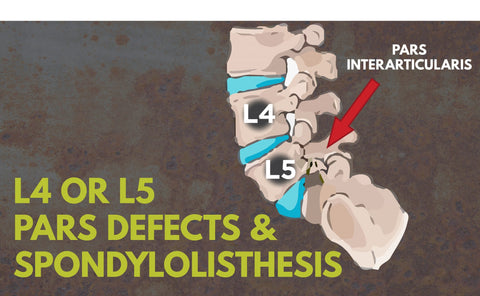What is Isthmic Spondylolisthesis? Symptoms, Causes and How to Treat it
What Is Isthmic Spondylolisthesis?
Spondylolisthesis is a condition in which one of the bones in your vertebra slides forward or backward over the bone next to it. There are a number of types or causes of spondylolisthesis with the most common being isthmic spondylolisthesis. Isthmic spondylolisthesis definition refers to a sliding of the vertebral body forward as the result of a tiny fracture in the bone that connects the joints on the back part of the spine known as the pars interarticularis. These stress fractures themselves are a condition known as isthmic spondylolysis.
Most often, isthmic spondylolysis affects the L5-S1 vertebra of the spine, which is the lowest or fifth vertebra of your lumbar spine that connects to the first sacral segment. Since the most common region of your spine for this to occur is your lower back, it rarely occurs above the level of the lumbar spine. When it does, the cause is more likely to be a result of trauma.
Aside from the different types of spondylolisthesis, the severity of this condition can be measured using a grading system in which your grade is based on the degree of slippage of your vertebrae, grade 1 being least severe and grade 5 being most severe. For cases of isthmic spondylolisthesis, it’s typical that you will only have grade 1 or grade 2 isthmic spondylolisthesis. Although it is possible to have the other grading as well, depending on your condition. Read more about to help diagnose and treat grades 1, 2, 3, 4, and 5 spondylolisthesis.
What Are Isthmic Spondylolisthesis Symptoms?
Isthmic spondylolisthesis typically occurs in younger individuals but your symptoms usually don’t occur until adulthood. Isthmic spondylolysis or spondylolisthesis is estimated to affect roughly 5% to 7% of the population, but in most instances, there are little to no symptoms. But for those unlucky individuals who do experience symptoms with isthmic spondylolisthesis, some of the more common ones include:
- Low-back pain
- Muscle spasms
- Sciatica
- Tight hamstring muscles
- An altered gait
- Nerve compression
- Spinal Stenosis
- Limping or imbalances while walking
- Weakness, numbness, tingling that radiates to your leg or foot
- Pain typically worsens when you walk, stand, twist, or bend
How Can I Treat Isthmic Spondylolisthesis?
Fortunately, most instances of isthmic spondylolisthesis can be treated using conservative methods. To start, an easy way to reduce the swelling or inflammation caused by adult spondylolisthesis is by using hot and cold therapy. Ice is used to relieve your pain and the heat is used to promote blood flow in our back region. In addition, anti-inflammatory medication can be used to reduce inflammation.
Back supports are also a good conservative way to help treat your pain caused by spondylolisthesis. Such braces help immobilize your back and help prevent you from moving it, which could further cause injury. Whether your spondylolisthesis occurs in your cervical, thoracic, or lumbar region, we have numerous options to help treat each area of your spine!
Spondylolysis and spondylolisthesis treatment also involves building up the muscles of the back and abdomen. Such physical therapy for isthmic spondylolisthesis treatment includes time working to improve the flexibility of these areas. The point of such isthmic spondylolisthesis exercises is to teach motions patterns that are less stressful to the back as well as to stabilize the spine and reduce the amount of pressure the lumbar spine must endure. Here are a few isthmic spondylolisthesis exercises that can help alleviate your symptoms:
- Dead bug: You begin this exercise on your back with the knees bent, feet flat against the floor and arms at your sides. Draw the belly button toward the spine as you tighten the abdomen. Keeping the legs bent, lift one of them off the floor and hold it for five seconds before lowering it to the ground and lifting the other leg for five seconds. Next, lift one arm over the head; hold it for five seconds then lower it. Repeat with the other arm. Once this becomes easy, you can double up, lifting a leg and the opposite arm at the same time. Repeat this sequence for five to ten repetitions in sets of three.

- Partial curl: To start, lie on your back with the knees bent and the feet flat against the floor. Tuck the chin to the chest and curl the upper body forward to lift the shoulders off the floor with your hands straight out in front of you. Hold this pose for three seconds before relaxing the abs and uncurling the upper back down to the floor. Breathing out can help you lift the shoulders off the floor. Repeat this exercise 10 times for three sets. To make this more difficult, you can clasp the hands behind the head with the elbows pointed out to the sides (like a crunch) as you perform this exercise.

- Quadruped arm/leg raises: For this back exercises for spondylolisthesis, begin on your hands and knees. Tighten the abdominals; while doing so, raise one arm and the opposite leg. Hold this pose for five seconds and then lower the leg and arm to the ground and repeat with the opposite arm and leg. Complete 10 repetitions on each side.

Isthmic Spondylolisthesis Surgery
If your condition is unresponsive to conservative treatment or the slippage of the spine advances to a more advanced grade or compression on the nerves of the spine results, surgery may be necessary.
Isthmic spondylolisthesis surgery typically involves fusing the problematic vertebra to another with bone grafting, screws, rods, etc. A laminectomy to create more space in the spine and ease pressure on the nerves of the spine may also be necessary.
Surgery for isthmic spondylolisthesis has a success rate of roughly 85% to 90%.











